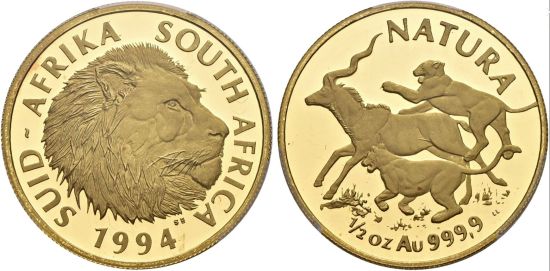Difference between revisions of "South Africa 1994 1/2 ounce"
m (Text replacement - " .999 fine" to " 0.999 fine") |
m (Text replacement - "Zurich," to "Zürich,") |
||
| Line 1: | Line 1: | ||
[[Image:S83-3647.JPG|550px|thumb|Sincona sale 83, lot 3647]] | [[Image:S83-3647.JPG|550px|thumb|Sincona sale 83, lot 3647]] | ||
| − | This specimen was lot 3647 in Sincona sale 83 ( | + | This specimen was lot 3647 in Sincona sale 83 (Zürich, May 2023), where it sold for 1,100 CHF (about US$1,472 including buyer's fees). The catalog description<sup>[1]</sup> noted, "[[South Africa|SOUTH AFRICA]], Republik, seit 1960. 1/2 Unze 1994, Pretoria. Proof. Natura - Lion. ''Selten. Nur 3'999 Exemplare geprägt'' (Rare. Only 3,999 pieces struck. PCGS PR69 DCAM)." South Africa, after a turbulent history between English and Dutch settlers and the native population, was constituted the Union of South Africa in 1910. Coinage commenced in 1923. The krugerrand was introduced in 1967 as a one ounce gold bullion coin and was very popular around the world despite bearing the effigy of Paul Kruger, the chief exponent of apartheid. The white supremacist regime was ousted in 1989 but, amazingly enough, the krugerrand remains in production. As competition for it, the South African government also marketed the Natura series, featuring various animals native to the region. The lion is depicted on this issue of 1994, the first of the series. |
''Recorded mintage:'' 3,999. | ''Recorded mintage:'' 3,999. | ||
Revision as of 08:48, 11 June 2025
This specimen was lot 3647 in Sincona sale 83 (Zürich, May 2023), where it sold for 1,100 CHF (about US$1,472 including buyer's fees). The catalog description[1] noted, "SOUTH AFRICA, Republik, seit 1960. 1/2 Unze 1994, Pretoria. Proof. Natura - Lion. Selten. Nur 3'999 Exemplare geprägt (Rare. Only 3,999 pieces struck. PCGS PR69 DCAM)." South Africa, after a turbulent history between English and Dutch settlers and the native population, was constituted the Union of South Africa in 1910. Coinage commenced in 1923. The krugerrand was introduced in 1967 as a one ounce gold bullion coin and was very popular around the world despite bearing the effigy of Paul Kruger, the chief exponent of apartheid. The white supremacist regime was ousted in 1989 but, amazingly enough, the krugerrand remains in production. As competition for it, the South African government also marketed the Natura series, featuring various animals native to the region. The lion is depicted on this issue of 1994, the first of the series.
Recorded mintage: 3,999.
Specification: 15.55 g, 0.999 fine gold, 0.500 troy oz AGW, 27 mm diameter, this specimen 15.55 g.
Catalog reference: KM 191, Fr-B11.
- Hern, Brian, John Bothma and Hercie Pieterse, Hern's Handbook on South African Coins & Patterns, Ferndale, South Africa, 2013.
- Friedberg, Arthur L. and Ira S. Friedberg, Gold Coins of the World, From Ancient Times to the Present, 9th ed., Clifton, NJ: Coin and Currency Institute, 2017.
- Michael, Thomas, and Tracy L. Schmidt, Standard Catalog of World Coins, 1901-2000, 47th ed., Iola, WI: Krause Publications, 2019.
- [1]Richter, Jürg, SINCONA Auction 83, World and Swiss Coins and Medals, Zurich: SINCONA AG, 2023.
Link to:
